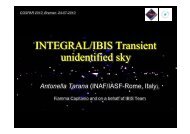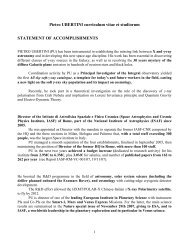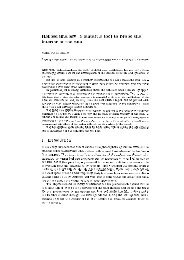X-ray Polarimetry - INAF-IASF-Roma
X-ray Polarimetry - INAF-IASF-Roma
X-ray Polarimetry - INAF-IASF-Roma
You also want an ePaper? Increase the reach of your titles
YUMPU automatically turns print PDFs into web optimized ePapers that Google loves.
Modern polarimeters dedicated to X-<strong>ray</strong> Astronomy exploit the<br />
photoelectric effect resolving most of the problems connected with<br />
Thomson/Bragg polarimeter. The exploitation of the photoelectric<br />
effect was tempted very long ago, but only since five-ten years it<br />
was possible to devise photoelectric polarimeters mature for a space<br />
mission.<br />
Heitler W.,The Quantum Theory of Radiation<br />
Costa, Nature, 2001<br />
sin<br />
cos<br />
5<br />
Z<br />
2 mc 2<br />
7 2 2<br />
2<br />
β =v/c<br />
4 2<br />
r o 4<br />
4<br />
137 h 1 cos<br />
By measuring the angular distribution of the ejected<br />
photelectrons (the modulation curve) it is possible to derive<br />
the X-<strong>ray</strong> polarization.<br />
An X-<strong>ray</strong> photon directed along the Z axis<br />
with the electric vector along the Y axis, is<br />
absorbed by an atom.<br />
The photoelectron is ejected at an angle θ<br />
(the polar angle) with respect the incident<br />
photon direction and at an azimuthal angle<br />
φ with respect to the electric vector.<br />
If the ejected electron is in ‘s’ state (as for<br />
the K–shell) the differential cross section<br />
depends on cos 2 (φ), therefore it is<br />
preferentially emitted in the direction of the<br />
electric field.<br />
Being the cross section always null for φ =<br />
90 o the modulation factor µ equals 1 for<br />
any polar angle.<br />
Paolo Soffitta The Extreme and Variable High Energy Sky Chia Laguna 19-21/09/2011






